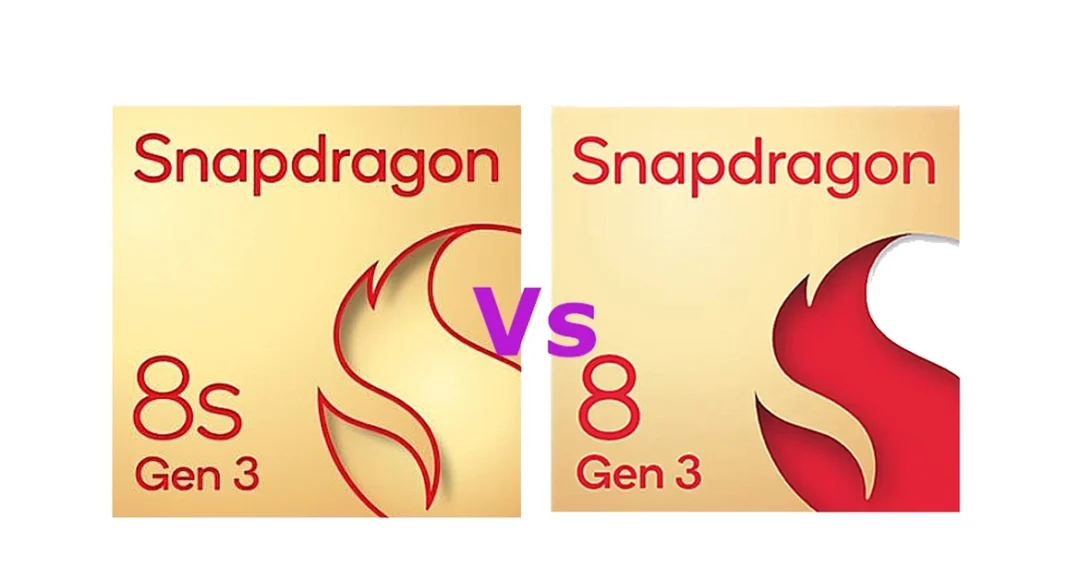Qualcomm is not new to introducing slightly tweaked versions of their flagship chipset. Back in 2022, the tech powerhouse released the Snapdragon 8+ Gen 1 SoC which promised 30% better power efficiency and 10% faster graphics than its predecessor. This chipset found its way into the flagship grade of 2022 like the OnePlus 10T and Samsung’s Galaxy Z 4 Series. In 2023 the S8+G2 powered flagship killers like Nothing Phone 2, iQOO Neo 7 Pro, and OnePlus 11R. Now, Qualcomm has introduced a new variant of its flagship Snapdragon 8 Gen 3 chipset. Dubbed Snapdragon 8s Gen 3, this SoC supports generative AI functions and dozens of LLMs and LVMs. However, unlike the S8+G1, the S8sG3 SoC is not as powerful as its predecessor.
Read Also: YouTube Music releases hum to search feature: Details inside
| Parameter | Snapdragon 8s Gen 3 | Snapdragon 8 Gen 3 |
| Process Node | TSMC 4nm | TSMC 4nm |
| CPU | Octa-core Kyro CPU - Advertisement -
1 Prime Cortex-X4 Core (3.0 GHz) 4 Performance Cores (2.8 GHz) 3 Efficiency Cores (2.0 GHz) |
Octa-core Kyro CPU
1 Prime Cortex-X4 Core (3.0GHz) - Advertisement -
5 Performance Cores (3.2 GHz) 2 Efficiency Cores (2.3GHz) |
| GPU | Adreno 735
HDR Gaming Hardware Accelerated Ray Tracing |
Adreno 750
HDR Gaming Hardware Accelerated Ray Tracing with Global Illumination |
| NPU | Hexagon NPU | Hexagon NPU |
| Camera Support | 4K HDR videos @ 60fps
Up to 200MP photo capture Slow-mo 1080p videos @ 240fps |
4K HDR videos @ 30fps
Up to 200MP photo capture Slow-mo 720p videos @ 960fps |
| Connectivity | WiFi 7, Bluetooth 5.4, LE | WiFi 7, Bluetooth 5.4, LE |
| Modem | Snapdragon X70 5G Modem
Maximum Download Speed: 5Gbps Maximum Upload Speed: 3.5Gbps |
Snapdragon X75 5G Modem
Maximum Download Speed: 10Gbps Maximum Upload Speed: 3.5Gbps |
| Storage/RAM Support | UFS 4.0 LPDDR5X memory up to 4,200MHz | UFS 4.0 LPDDR5X memory up to 4,800MHz |
In This Article
Snapdragon 8 Gen 3 has a higher-performing CPU
Both chipsets use 8 cores, although they are arranged differently. The Snapdragon 8s Gen 3 clocks slightly lower than the S8G3 SoC. The two chipsets have 1 prime Cortex-X4 core which clocks at 3.0GHz. The 8s Gen 3 has 4 performance cores clocked at 2.8GHz and 3 efficiency cores clocked at 2.0GHz. Meanwhile, the 8 Gen 3 has 5 performance cores running at 3.2GHz and 2 efficiency cores at 2.3GHz.
Snapdragon 8s Gen 3 is within touching distance of S8G3’s GPU performance
The Snapdragon 8s Gen 3 runs on the Adreno 735 GPU while the 8 Gen 3 is powered by Adreno 750. Both SoCs support Hardware Accelerated Ray Tracing, but Qualcomm’s flagship chipset also offers Global Illumination. This means that the Snapdragon 8s Gen 3 won’t have the added advantage of producing close-to-real lighting, shadows, and reflections. On the bright side, the Adreno 735 matches the 750 with HDR gaming, Adreno Frame Motion Engine 2.0, Shadow Denoiser, and more.
The 8s Gen 3 goes all guns blazing on the AI front
The Snapdragon 8s Gen 3 will bring a host of AI features to midrange and flagship killer smartphones of 2024. Using the same Hexagon NPU as the S8G3, the 8s G3 can run on-device AI models with up to 10B parameters. The chipset can handle tasks like AI image generation, photo expansion, and virtual assistance. There is support for over 30 LLMs and LVMs on the new S8sG3 chipset.
Let’s talk about the camera support
The two chipsets are capable of capturing up to 200MP photos. If we’re talking about the photo-capturing performance of the main sensor, the smartphones running the Snapdragon 8s Gen 3 will easily match their flagship counterparts. However, significant differences are bound to arise in the video-capturing department. While the S8G3 SoC can record 8K videos @ 30 fps, the S8sG3’s chops are limited to 4K videos @ 60fps. Even while recording slow-motion videos, the flagship chipset is capable of recording at an impressive 960fps while the 8s Gen 3 is limited to 240fps.
Storage and Connectivity
Both chipsets are pretty evenly matched when it comes to connectivity, with support for Bluetooth 5.4, WiFi 7, and Bluetooth LE Audio. However, the key difference lies in the download speed offered by the two SoCs, and the flagship chipset emerges as the clear winner. With the Snapdragon X75 5G modem on board, the 8 Gen 3 supports download speeds of up to 10Gbps. The Snapdragon X70 5G modem on the new chipset offers a maximum download speed of 5Gbps. The two chipsets rock UFS 4.0 storage and LPDDR5X memory, but the flagship chipset functions at 4,800MHz while the 8s Gen 3 is limited to 4,200MHz.
Read Also: Samsung announces Galaxy Ultra Days offering exciting deals on Galaxy S24 and S23 Ultra
Snapdragon 8s Gen 3 vs Snapdragon 8 Gen 3: Verdict
It should surprise no one that Qualcomm’s flagship chipset is the clear winner here. It has higher clock speeds, premium GPU features like Global Illumination, advanced video recording specs, better download speeds, and more. The good thing about the new Snapdragon 8s Gen 3 is that it almost matches these specs, trailing behind only by a very slim margin. This chipset will thrive on upper midrange smartphones this year and we are excited to try out the AI features it will bring to the segment.




